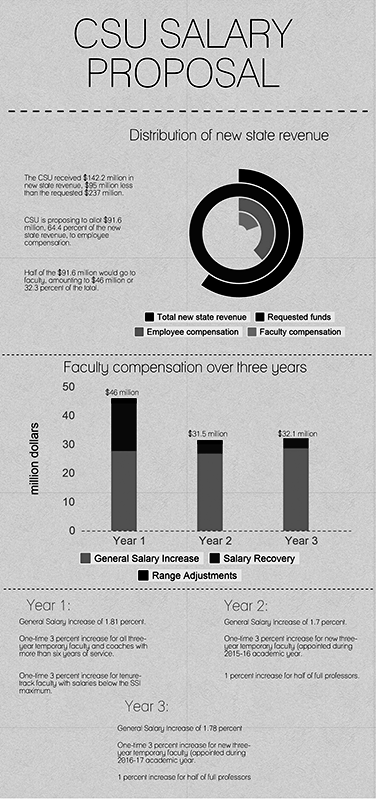Faculty contract negotiations on hiatus
September 4, 2014
California State University and the California Faculty Association agreed to extend their existing collective bargaining agreement until Sept. 30 at the end of the bargaining session on Aug. 18, but the CFA insisted salary and workload must be addressed before a conclusion can be reached.
The CSU’s salary proposal would allow for a general salary increase of 1.81 percent for the first year, 1.70 percent for the second year and 1.78 percent for the third year.
The proposal “guarantees a compensation pool increase that totals 3 percent of the compensation base for 2014-2015; 2 percent for 2015-2016; and 2 percent for 2016-2017,” and commits “to paying the proposed increases regardless of any shortfalls in state funding” unlike the 2007-2010 agreement, according to an Aug. 27 press release from the CSU.
The CFA stated it had “no serious disagreement with the CSU’s proposal on faculty salary for the first year of the contract…” but stressed, “…years two and three are equally important,” with the most serious shortcoming of the CSU salary proposal being the lack of Service Salary Increases, or SSIs, according to an Aug. 28 press release.
SSIs allow for employees who perform their job duties satisfactorily to receive salary increases until they hit a certain pre-determined limit, according to California State University, Sacramento’s Office of Human Resources.
According to the CFA, the present salary structure creates an “experience bias” that works against senior faculty and, “any resolution to the contract must include progression along with fixes to inversion, compression and misclassification.”
The salary structure has been a point of contention for years because of problems such as salary compression, affecting “senior faculty members at the top of their ranks who are no longer eligible for SSIs,” and inversion, affecting “experienced faculty” who “earn a lower salary than faculty newly hired at the same rank,” according to a 2006 resolution passed by the CSU Academic Senate.
The CFA proposed adopting the salary structure used by other state employees allowing for step increases to employees’ basic pay every year, according to the Aug. 28 press release.
The CSU addressed workload concerns by providing “an additional pool of $12 million dollars over the life of the agreement to fund teaching release time for probationary faculty, and for faculty with exceptional instructional or service commitments.”
The CFA had proposed creating three pools of $4 million each “to address excessive loads in teaching, service and research,” according to the Aug. 28 press release. Instead of having administrators decide “who gets workload help,” the CFA proposed working together in a shared governance framework to find a solution.
The CSU press release stated that despite receiving $95 million less than requested from the state, “the chancellor and board of trustees decided to allocate $91.6 million, or 64.4 percent, of the available $142.2 million in new state revenues to employee compensation, including a proposed $46 million specifically for faculty.”
According to the CFA, new state funds are not the only source of money that could be used for faculty salaries and workload.
“On every campus, there are funds that could be used to supplement student success initiatives and provide increased faculty time for this program,” according to the Aug. 28 press release.
Negotiations are scheduled to continue in September.
















